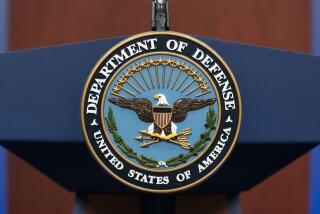Most U.S. Forces to End Somalia Duty by March 1
- Share via
WASHINGTON — The United States is expected to order the withdrawal of most American troops from Somalia by March 1, with the first contingent likely to leave this month, senior Administration officials said Wednesday.
Tentative plans now call for a residual force of less than 5,000 U.S. troops to remain onshore and a Marine contingent of about 2,200 to be stationed in Indian Ocean waters off Mogadishu for a period that military planners hope will not exceed “several months.”
And by March 1, American Lt. Gen. Robert B. Johnston, field commander for Operation Restore Hope, is expected to turn over command of forces in Somalia to the United Nations.
The tentative timetable provides the first detailed look at how the much-disputed U.S. withdrawal from Somalia will unfold. The Pentagon is counting on the provision for a continued presence of American troops to damp any concerns that the United States might be abandoning the mission prematurely.
The United States also is counting on its continued presence to encourage four or five other major allies, notably France and Italy, to remain as part of the U.N. force. France has about 2,500 troops in Somalia and Italy about 2,200, the Pentagon says.
The goal is to keep about 15,000 foreign troops--less than half the expected buildup of more than 32,000 from 19 countries--involved in Somalia.
The troops will remain under U.N. auspices until both the humanitarian effort and the political situation have been stabilized and officials are confident that troop withdrawals will not result in renewed warfare that could lead to a second wave of mass starvation, U.S. officials said.
As many as 300,000 Somalis are believed to have died from famine and warfare, and millions more are still considered in danger, international relief agencies say. Thousands of Somalis still have not received food assistance since the original American deployment on Dec. 9.
The purpose of the offshore Marine contingent will be largely psychological, to discourage attempts by the nation’s feuding warlords to challenge U.N. authority.
While the warlords welcomed the U.S.-led deployment, the United Nations has had a troubled recent history in Somalia. Last weekend, U.N. Secretary General Boutros Boutros-Ghali’s visit to Mogadishu was met with demonstrations and rock-throwing at U.N. headquarters there.
The projected U.N. force will have a distinct advantage over the original U.N. deployment, when limited rules of engagement and limited weaponry left it highly vulnerable to attack. The U.N. force will continue to operate under new rules of engagement established during Operation Restore Hope, in effect making it a peacemaking rather than just a peacekeeping force, U.S. officials said.
Although the new Clinton Administration will have final authority over the timing of a withdrawal, the size of the residual force and its functions, U.S. planners expect the new defense secretary and the White House to go along with current Pentagon recommendations.
In his announcement of Operation Restore Hope last month, President Bush indicated that he hoped the American contingent would be completely or mostly out of Somalia by the time he hands over power to Clinton on Jan. 20. But senior Pentagon officials have always said that the operation would take longer.
The final total of American troops is expected to be about 24,000, down from initial estimates of 28,000. U.S. military planners found that the additional troops were not needed. Almost 21,000 are now deployed in Operation Restore Hope--more than 16,000 in Somalia and almost 4,000 on the Tripoli and two other ships offshore.
Troops from 18 other countries, already deployed in Somalia, now exceed 8,000, the Pentagon says. And not all nations’ forces have yet arrived.
Once the United States has turned over command of the international humanitarian effort to the United Nations, American forces are expected to come under control of a U.N.-designated commander in an arrangement still to be worked out, the Administration sources said.
Pentagon planners are confident they can meet the March 1 date, in part because of significant progress over the last month in eliminating rival clans’ heavy weaponry--notably the well-armed “technicals” (jeeps and small trucks with machine guns and other weapons mounted on them)--and in building the embryo of a new power structure.
The arrival in Mogadishu Wednesday of more helicopters in C-5 cargo planes is expected to speed the effort to locate and eliminate large weapons, especially in the countryside. U.S. troops are not, however, going house to house to remove small arms. Simultaneously, the U.S. mission has been working with various Somali groups to rebuild and restore local leadership.
More to Read
Sign up for Essential California
The most important California stories and recommendations in your inbox every morning.
You may occasionally receive promotional content from the Los Angeles Times.










